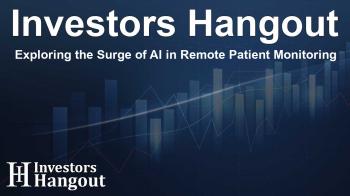Exploring the Surge of AI in Remote Patient Monitoring

AI Transforming the Remote Patient Monitoring Landscape
The global remote patient monitoring market is on the brink of a significant transformation, with the latest predictions estimating its value to soar to USD 8,438.5 million by 2030. This shift is largely attributed to the adoption of artificial intelligence (AI) techniques that are enhancing healthcare delivery.
Driving Forces Behind Market Growth
The expansion of telehealth services is a key driver of this growth. More patients than ever are gaining access to healthcare through virtual consultations and real-time monitoring. The rise in favorable reimbursement policies further supports this development, ensuring that both patients and providers can benefit from innovative technologies.
Legislative Support for AI Adoption
Recent supportive legislation, such as the Telehealth Modernization Act in the U.S., is paving the way for better integration of telehealth services. This regulatory environment encourages innovative healthcare solutions like AI-driven remote patient monitoring, ensuring effective and patient-centered care.
Why Timely Remote Monitoring is Crucial
In an age where chronic diseases are on the rise and hospital capacities are often overstretched, AI-enabled remote patient monitoring has become vital. This solution allows healthcare providers to detect conditions early, manage patients from afar, and reduce unnecessary hospital visits. It’s especially beneficial in acute care, behavioral health, and chronic disease management.
CMS and Reimbursement Extensions
The Centers for Medicare & Medicaid Services (CMS) have expanded reimbursement options for AI-assisted remote patient monitoring, thus encouraging greater adoption among healthcare providers. This shift signifies the importance of integrating technology into patient care.
Market Dynamics: Current Opportunities and Challenges
The current market dynamics include various drivers and challenges. The rapid integration of wearable devices and AI analytics is fostering exciting new opportunities. As of March 2023, numerous state Medicaid programs have initiated coverage for remote patient monitoring, and the FDA has approved numerous AI-enabled diagnostic tools.
Challenges Facing the Industry
Despite the positive outlook, challenges remain, especially concerning regulatory inconsistencies across different global regions. Variability in definitions of medical devices presents hurdles in achieving a consistent global market. Additionally, data privacy and security are pressing issues that need addressing to build confidence in AI solutions.
Regional Growth Potential
The Asia Pacific region is anticipated to witness the fastest growth in this sector. Factors contributing include rapid digital health adoption and investments in medical infrastructure. Countries are increasingly focused on innovative solutions, such as AI-driven wearable devices, which enhance remote patient monitoring capabilities.
Strategic Recommendations for Market Leaders
Healthcare leaders and decision-makers should view the AI in remote patient monitoring market as a strategic opportunity. By leveraging AI, hospitals can optimize care delivery and resource allocation while insurers can minimize long-term costs through incentive programs.
Technological Integration for Better Outcomes
The convergence of AI, mobile technology, and telehealth is redefining traditional healthcare models. The integration of AI in these platforms is becoming more than just a benefit; it’s a necessity to ensure comprehensive and effective healthcare delivery as we move forward.
Conclusion: Shaping the Future of Healthcare
The growth of AI in remote patient monitoring is not merely a trend; it represents a long-term shift in how healthcare services will be provided. This evolution enhances the possibilities of predictive, proactive, and personalized healthcare, revolutionizing patient interactions across the globe.
Frequently Asked Questions
What is the predicted market value for AI in remote patient monitoring by 2030?
The predicted market value is expected to reach USD 8,438.5 million by 2030.
What drives the growth of AI in remote patient monitoring?
Growth is largely driven by the expansion of telehealth services and supportive reimbursement policies.
How does AI improve patient outcomes in remote monitoring?
AI allows for earlier condition detection and more effective management of patients, reducing unnecessary hospitalizations.
What challenges does the remote patient monitoring market face?
Challenges include regulatory inconsistencies, data privacy concerns, and the need for accurate AI model training.
Which region is expected to grow fastest in this market?
The Asia Pacific region is expected to post the highest growth due to increased digital health adoption and innovation.
About The Author
Contact Dylan Bailey privately here. Or send an email with ATTN: Dylan Bailey as the subject to contact@investorshangout.com.
About Investors Hangout
Investors Hangout is a leading online stock forum for financial discussion and learning, offering a wide range of free tools and resources. It draws in traders of all levels, who exchange market knowledge, investigate trading tactics, and keep an eye on industry developments in real time. Featuring financial articles, stock message boards, quotes, charts, company profiles, and live news updates. Through cooperative learning and a wealth of informational resources, it helps users from novices creating their first portfolios to experts honing their techniques. Join Investors Hangout today: https://investorshangout.com/
The content of this article is based on factual, publicly available information and does not represent legal, financial, or investment advice. Investors Hangout does not offer financial advice, and the author is not a licensed financial advisor. Consult a qualified advisor before making any financial or investment decisions based on this article. This article should not be considered advice to purchase, sell, or hold any securities or other investments. If any of the material provided here is inaccurate, please contact us for corrections.

